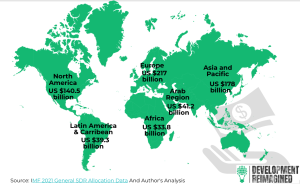It has been almost a year and half since the International Monetary Fund (IMF) announced its largest global allocation of SDRs, US $650 billion (or SDR 456.5 billion), to member countries to boost global liquidity and address the global need for reserves.
Although many in the international community acknowledged the importance of this allocation, particularly in the midst of the COVID-19 pandemic and on-going crises across the world, many also quickly pointed out the unequal distribution of SDRs, with low income countries receiving the smallest share. This unequal distribution is due to the IMF’s age-old quota system where SDRs are allocated based on their IMF quota share.
From the US $650 billion allocation, Africa as a whole received approximately US $33.8 billion, which is around 5% of the total allocation. On the other hand, countries such as the United States received approximately US $113 billion or 17% of the allocation.
So, although there is an unequal distribution across the globe, how are SDRs distributed within the African continent? And have African countries been using their SDRs effectively? From our research and data collection, there are three main takeaways:
- The top 10 African countries with the largest SDR allocations account for 62.5% of the total allocation to the continent. South Africa has been allocated the largest amount of SDRs, which amounts to US $4.15 billion. On the other hand, other countries like Sao Tomé and Principé have only received a very small portion of approximately US $20 million. The unequal distribution of SDRs we see globally is also vividly seen on the continent.
- The African continent has the highest take up rate of SDRs in the world, which is almost 90%. African countries have utilized their allocated SDRs for various economic and social purposes, with most of them being used to supplement their national budgets and boost their foreign reserves. In addition to these two uses, African countries have utilized SDRs for pandemic-related spending, social measures, debt servicing, health, and economic recovery, among others. For instance, Cabo Verde utilized all of its newly allocated SDRs to finance its budgets for the years 2021 and 2022 and to support pandemic recovery efforts. Similarly, Comoros used some of its newly allocated SDRs in 2021 to provide cash transfers to its poor population.
- China has committed to reallocating its SDRs worth US $10 billion solely to the African continent. However, only a few high-income countries have committed to reallocating their SDRs to the IMF’s Resilience and Sustainability Trust. It is important for more countries to step up and increase their SDR reallocation commitments, not just to the IMF but also to other critical institutions such as the African Development Bank.

March 2023


